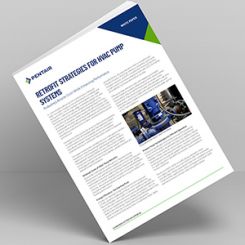Q. What causes radial thrust on volute pump impellers? Should the pressure in the volute be uniform with proper design? |
A. Single and dual volute pumps are typically designed for uniform mean velocity around the volute of the casing at the design rate of flow (BEP). For pumps in operation near or at BEP, the radial thrust may approach zero. For operation at flow rates higher or lower than BEP, the pressure distribution is not uniform, resulting in a radial thrust on the impeller. The magnitude and direction of the radial thrust changes with changes in flow rate. The following expression is used to calculate radial thrust: |
Metric Units |
FR = KR x (H x s/2.31) x D2 x b2 |
Where: |
FR = Radial thrust, in Newtons (pounds) |
KR = Thrust factor, which varies with flow rate and specific speed. (See Figure 1.3.5.1.d.) |
H = Developed head per stage, in meters (feet) |
ρ = Density of pumped liquid, in kilograms per cubic meter |
s = Specific gravity of pumped liquid |
D2 = Impeller diameter, in meters (inches) |
B2 = Impeller width at discharge including shroud(s), in meters (inches) |
g = 9.81 m/s2 (gravitational constant) |
For single volute pumps, the highest value of radial thrust is typically at zero flow in a direction from the shaft centerline toward the narrower part of the volute casing. As the flow rate increases, the load loses magnitude until it reaches its minimum at or near the BEP. |
For pumps of low specific speed design, ns = 10 (Ns = 500), the minimum radial thrust value may be observed at about 80 percent of the BEP flow rate. The magnitude of the force then increases at flow rates over BEP and its direction shifts toward the wider volute area. |
Exact direction of radial force at various flow rates is highly dependent on the pump specific speed and design parameters of the volute. Zero value of radial thrust is not often realized. Figure 1.3.5.1d shows values of the radial thrust factor for different specific speeds and percent of BEP flow. |
Double volute and circular (concentric) casings have different values for the radial thrust factor. That information and more on this subject can be found in the recently revised edition of ANSI/HI 1.3 Rotodynamic (Centrifugal) Pumps for Design and Application. This revised standard includes additional content and graphics, a broadened scope and an enhanced section on different pump types. |
Q. What causes some vertical pumps to run backward when shut down, and can this be a problem? |
A. A sudden power and/or check valve failure during pump operation against a static head will result in a flow reversal, and the pump will operate in the opposite direction of rotation from that of normal pump operation. If the pump is driven by a prime mover offering little resistance while running backward, the reverse speed may approach its maximum speed consistent with zero torque. This speed is called runaway speed. The runaway speed may exceed that of the corresponding normal pump operation. This excess speed may impose high mechanical stresses on the rotating parts of both the pump and the prime mover. Therefore, knowledge of this speed during initial design work is essential to safeguard the equipment from possible damage. |
Refer to ANSI/HI 2.4 Rotodynamic (Vertical) Pumps for Manuals Describing Installation, Operation, and Maintenance for more information on this and other operational problems. Also see the revised ANSI/HI 2.3 Rotodynamic (Vertical) Pumps for Design and Application, which now has extensive new content and expanded graphics. |
Q. Besides varying pump speed, how can the flow rate from metering pumps be adjusted? |
A. Controlled-volume metering pumps with stroke length adjustment typically have a flow rate adjustment range between 10 and 100 percent of rated flow, expressed as a turndown ratio of 10:1. Below the stated turndown, accuracy cannot be guaranteed. The pump should be sized such that the entire flow range falls between 10 and 100 percent of the pump's flow rate. |
Controlled-volume metering pumps may also use stroke frequency adjustment with turndown ratio dependent on the stroking speed of the pump and turndown capability of the driver. Greater turndown range can be achieved in some applications by using both stroke length adjustment and driver speed control when maximum flow rate is greater than 10 times minimum flow. The pump manufacturer must confirm extended turndown range. |
For optimal performance and most economical operation, a pump should be sized to operate at the top 30 percent of its rated flow rate. Operation in this range promotes the highest accuracy. |
For more information on this subject see the revised edition of ANSI/HI 7.1-7.5 Controlled Volume Metering Pumps, which now includes information on more pump types including plunger, piston, mechanical coupled disc diaphragm, hydraulic coupled disc diaphragm, hydraulic coupled tubular diaphragm and hydraulic coupled conical diaphragm. |

